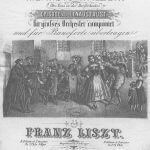When you hear of the Mephisto Waltz, what comes to mind is the No. 1 in the series of four waltzes by Franz Liszt.

No. 1 is the most popular of the Mephisto Waltzes with renditions from different classical pianists. It is a dramatic piece that has always been a favourite of concertgoers around the globe. No. 1 is written to evoke feelings that range on a broad spectrum from joy to passion. If you have never heard of the Mephisto Waltzes: these are four waltzes which Franz Liszt composed between 1859 and 1862, 1180 and 1881, 1883 and 1885. Number 1 and Number 2 were written for orchestra, but later revised for piano, two pianos and piano duet. Number 3 and Number 4 were composed only for piano..
As I listen to Mephisto waltz, I can clearly imagine the scene it was made for.
Of these four waltzes the most popular one, and also the one that has been performed the most often, is undoubtedly Waltz number 1. It has been recorded many times and are often still performed in concert halls throughout the world. Mephisto Waltz No. 1, S.514 (also known as The Dance in the Village Inn) is the second of two productions Liszt composed for orchestra. Because of its sensuality, passion and dramatics this mephisto waltz has often been described as having a ‘deep emotional impact’ on listeners. James Huneker referred to the piece’s melody as ‘one of the most voluptuous episodes outside of the Tristan score”. The story behind the waltz involves Faust and Mephistopheles arriving at a wedding ceremony which has already started. Mephistopheles convinces Faust to take part in the celebrations and while the former entertains the townsfolk with his fiddle playing Faust starts to dance with a beautiful young girl from the village.
[embedyt] https://www.youtube.com/watch?v=1YcEspUvHlQ[/embedyt]
The Mephisto Waltz No 1, S 514 Der Tanz in der Dorfshenke or Dance in the Village Inn is the version that was arranged for piano. Liszt did a lot of reworking of the Mephisto Waltzes, including an alternate conclusion for the orchestra version of the No. 1. Franz Liszt composed this waltz between 1859 and 1862, and it came after Midnight Possession and Der nächtliche Zug, also recorded at the same time. This waltz is based on the program notes of Lenau’s poetry rather than Goethe’s. Liszt intended for the No. 1 and Midnight to be recorded simultaneously but they were not. The two pieces cover Nikolai Lenau’s first two episodes of his Faust poems and are similar in their portrayal of contrasting emotions even though their themes are not related in any way. No. 1 and No. 3 are the Mephisto Waltzes that have achieved acclaim for their ability to spur provocative emotions.
Their amorous dancing propels them right out of the dance hall, then out of the village and finally into a forest where the sounds of the fiddle slowly fades into the distance
Listz wrote two possible endings for the waltz, one which faithfully sticks to the storyline above and another one (which has become more common) which slowly builds up this lovely mephisto waltz to an exuberant climax. With such a deeply emotional commitment to music I found the waltz’s immense emotional scope, which embraces not only periods of intense tenderness, but also moments of nearly devilish mischief, nearly irresistible. And of course the magnificent surroundings, which add an additional dimension to this superb piece of music, was another factor that convinced me to record this waltz.
Leave a Reply